The HVAC industry is in the midst of yet another refrigerant transition, moving away from high-GWP options like R-410A in many types of comfort cooling equipment, towards lower-GWP alternatives such as R-32 and R-454B, which are mildly flammable (A2L) refrigerants. This transition is part of the AIM Act, which tasked the Environmental Protection Agency (EPA) with reducing the production/import and usage of HFCs by 85% by 2036. To reach that goal, an additional 30% reduction in HFC production went into effect on January 1, 2024 (on top of the 10% reduction in 2022), and a 700 GWP limit will be required for many types of new residential and light commercial air conditioning equipment, starting January 1, 2026.
At the forefront of this transition are the refrigerant and equipment manufacturers, which have been strategizing and preparing for this transformative change for years. At the AHR Expo, these manufacturers shared the ways in which their companies are navigating the challenges posed by the refrigerant transition in the comfort cooling sector, as well as the impacts this will have on the HVAC industry as a whole.
System Redesign
In preparation for the HFC phasedown, Daikin is redesigning systems that used higher-GWP R-410A and R-134a to use lower-GWP refrigerants including R-32 (675 GWP), said Phil Johnston, environmental business development leader at Daikin Applied Americas.
“We know that single component R-32 has greater latent heat capacity than R-410A, which means that R-32 can achieve the same capacity at a lower refrigerant flow rate. And, at a lower flow rate, less energy is required to produce refrigerant flow, resulting in higher efficiencies for R-32. Full- and part-load efficiency can be improved by up to 12% using R-32 instead of R-410A,” said Johnston.
In addition, R-32 is a pure, single-component refrigerant with excellent thermodynamic performance characteristics, he noted, and Daikin's analysis indicates that an R-32 system can be engineered to have 40% less charge than a similar R-410A system.
“This means you could reduce the amount of refrigerant in the system, which could potentially reduce the amount of refrigerant leaking to the environment, as well as allow HVAC engineers the opportunity to design smaller compressors and coils,” he said.
On the commercial side, Daikin highlighted several low-GWP products at the AHR Expo, including the Trailblazer scroll chiller AGZ-F with R-32; Rebel heat pump with R-32; Rebel Applied with R-32; SmartSource compact horizontal water-source heat pump with R-32; and Magnitude WMT magnetic bearing chiller with R-1233zd.
Daikin is also reengineering all of its residential ducted, ductless, and packaged products, from 5 tons and below, to use R-32 by the end of 2024, said David Palazzolo, director of residential product marketing at Daikin.
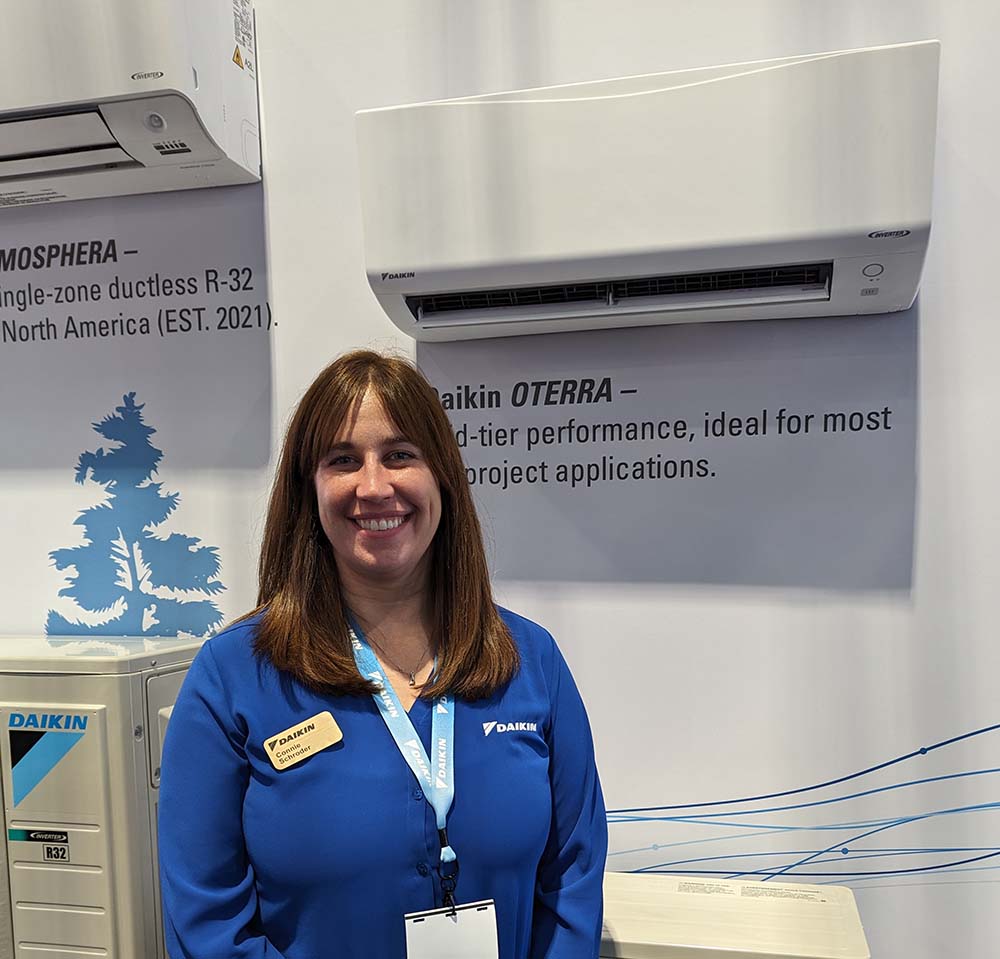
NEW SYSTEM: Connie Schroder shows off Daikin’s new OTERRA single-zone ductless system. (Staff photo)
Some of the R-32 residential products displayed at the booth included the Atmosphera single-zone ductless system, which offers efficiencies up to 27.4 SEER2 and 11.2 HSPF2; the new Oterra single-zone ductless system, which features efficiencies up to 21 SEER2 and 10.2 HSPF2; and the Altherma air-to-water heat pump system, which provides heating and cooling for the home as well as domestic hot water.
“Daikin has been using R-32 refrigerant in products globally since 2012, which makes the transition here in North America easier from a refrigerant standpoint, since we’re using a proven refrigerant with 12 years of usage in over 230 million systems manufactured by Daikin and other manufacturers,” said Palazzolo.
Sustainable Strategy
Arkema is responding to the HFC phasedown by expanding production of R-32 in order to meet the needs of the industry for lower-GWP HFCs. This year, the company also plans to open the new Forane 1233zd line at its Calvert City, Kentucky plant.
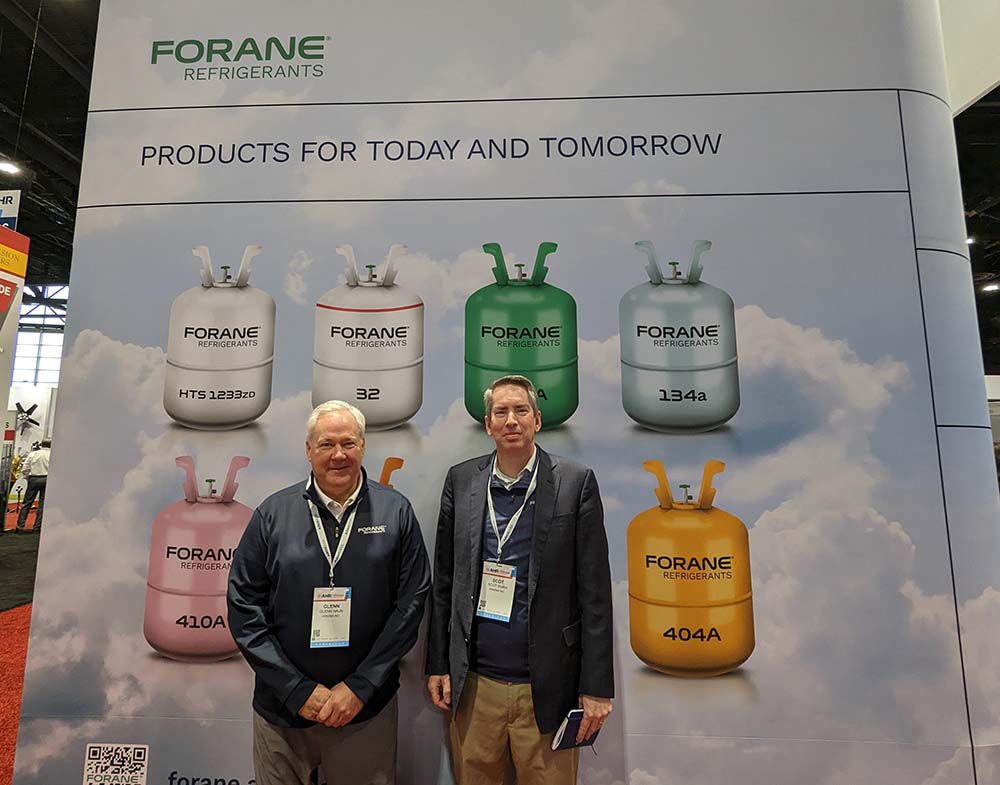
MEETING DEMAND: Glenn Haun (left) and Scot Swan discuss how Arkema is expanding production of R-32 to meet demand for lower-GWP HFCs. (Staff photo)
“The significant investment will include the retrofit of the R-134a production line and supports Arkema’s climate plan to reduce greenhouse gas emissions by 46% in 2030 versus 2019 on the full value chain,” said Glenn Haun, general manager of fluorochemicals at Arkema. “R-1233zd is part of the new generation of fluorospecialties with no or minimal emissive impact, aligned with Arkema’s sustainable development strategy to address global needs. Forane 1233zd has an ultra-low-GWP of 1 and is also low pressure, non-ozone depleting, and exempt from VOC regulations.”
R-1233zd HTS can be used in centrifugal chillers where R-11 or R-123 were traditionally used, and it has already been adopted by a number of global OEMs for their next-generation chillers, said Haun. R-1233zd is also being tested in some high-temperature heat pump applications.
Arkema also highlighted the R-410A replacement, R-32, which is designed for use in new air conditioning and heat pump applications. Haun noted that R-32 exceeds the energy efficiency and capacity of the refrigerants it replaces and that the transition to this lower-GWP refrigerant will start in earnest this year.
“We hope that the technicians installing the new equipment containing these refrigerants will be up to speed by the second half of 2024 when many of the new systems start rolling out,” said Haun. “Technicians can still get trained with the help of their OEM partners, or organizations such as ACCA or NATE.”
vice president of regulatory, codes, and environmental affairs
Johnson Controls
Spring Production
In light of the HFC phasedown, Johnson Controls is redesigning all of its residential and light commercial ducted equipment to utilize R-454B (466 GWP) across all its ducted product lines and R-32 for its ductless offerings, said Chris Forth, vice president of regulatory, codes and environmental affairs at Johnson Controls. He added that the company is already transitioning its factories from R-410A to R-454B (ducted) and R-32 (ductless) equipment, with the first production beginning this spring.
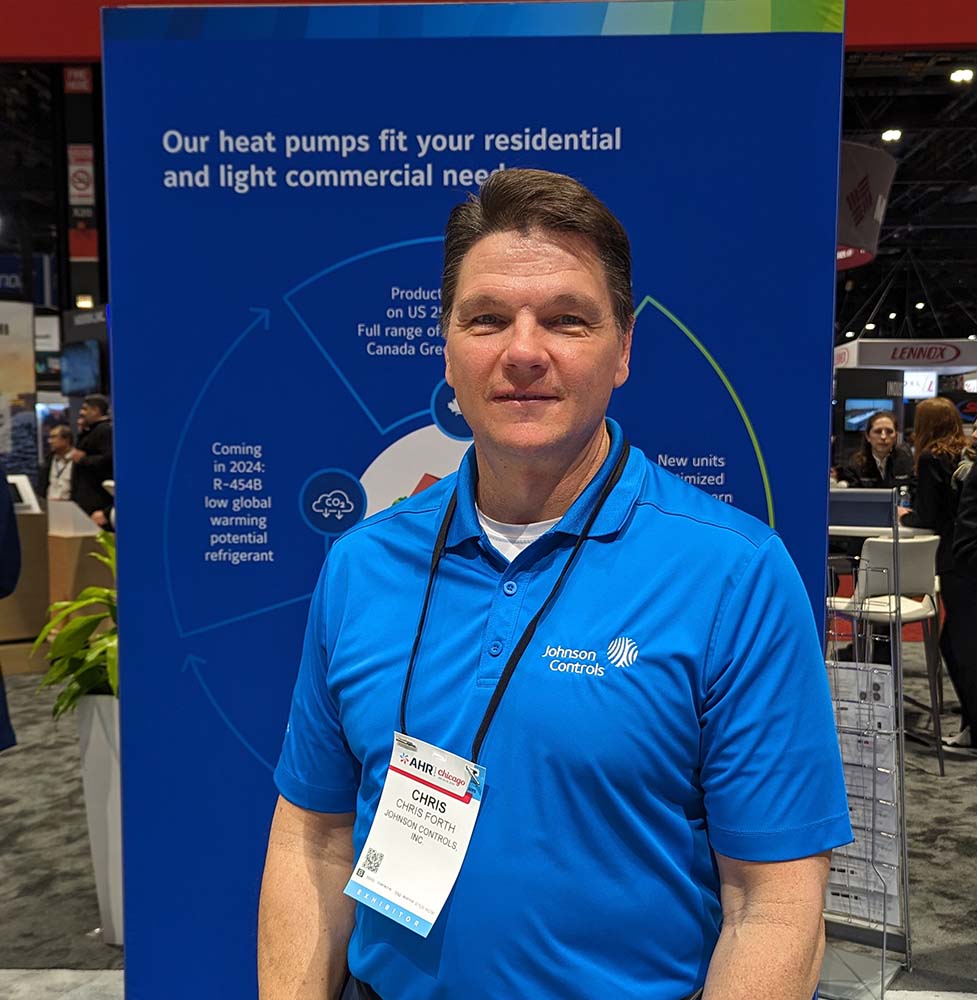
FACTORY TRANSITION: Chris Forth noted that Johnson Controls is already transitioning its factories from R-410A to R-454B and R-32 equipment. (Staff photo)
“There are many benefits to new A2L refrigerants,” he said. “Use of R-454B, for instance, provides a 78% reduction in GWP while improving HVAC system efficiency and maintaining similar operating characteristics to R-410A. R-454B also requires less charge than R-410A when fully optimized, while its pressures and temperatures are very similar to R-410A.”
Forth added that Johnson Controls is also adding product features that make working with the new A2L refrigerants even safer.
“At the AHR Expo, we showcased our new refrigerant detection systems (RDS) that detects refrigerant leaks for residential and commercial equipment that operate using R-454B (ducted) or R-32 (ductless),” said Forth. “The RDS will be required by code in certain applications and optional in others. Johnson Controls has developed an innovative RDS Calculator tool that helps customers understand when it is required by code. This tool will be available both in its product selection tools and in the Ducted Systems Solutions app.”
In addition to the RDS systems designed for residential and commercial equipment, Johnson Controls has developed new heat exchanger technologies designed to minimize refrigerant charge volumes, as well as improve efficiency and cost, said Forth. He noted that the new heat exchangers, as well as the compressor, are specifically optimized for use with R-454B (ducted) and R-32 (ductless).
Not surprisingly, contractors have a lot of questions about A2Ls, and a smooth refrigerant transition requires comprehensive education and preparation across the entire channel, said Forth. As such, contractors should prioritize three key goals for a successful shift: recovering and reclaiming R-410A, understanding low-GWP alternatives, and ensuring A2L refrigerant safety.
“With proactive preparation and education — which includes our on-site refrigerant training courses at Ducted Systems Academy and our free online resources — contractors can move through the transition with limited disruption and gain a competitive advantage, but they have to act now to be prepared,” said Forth.
Exceeding Performance
Chemours has prepared for the 40% cut in HFC production in 2024 by developing refrigerants with up to 96% lower GWP than heritage HFC refrigerants, said Andrew Pansulla, senior technical service engineer of refrigerants at Chemours.
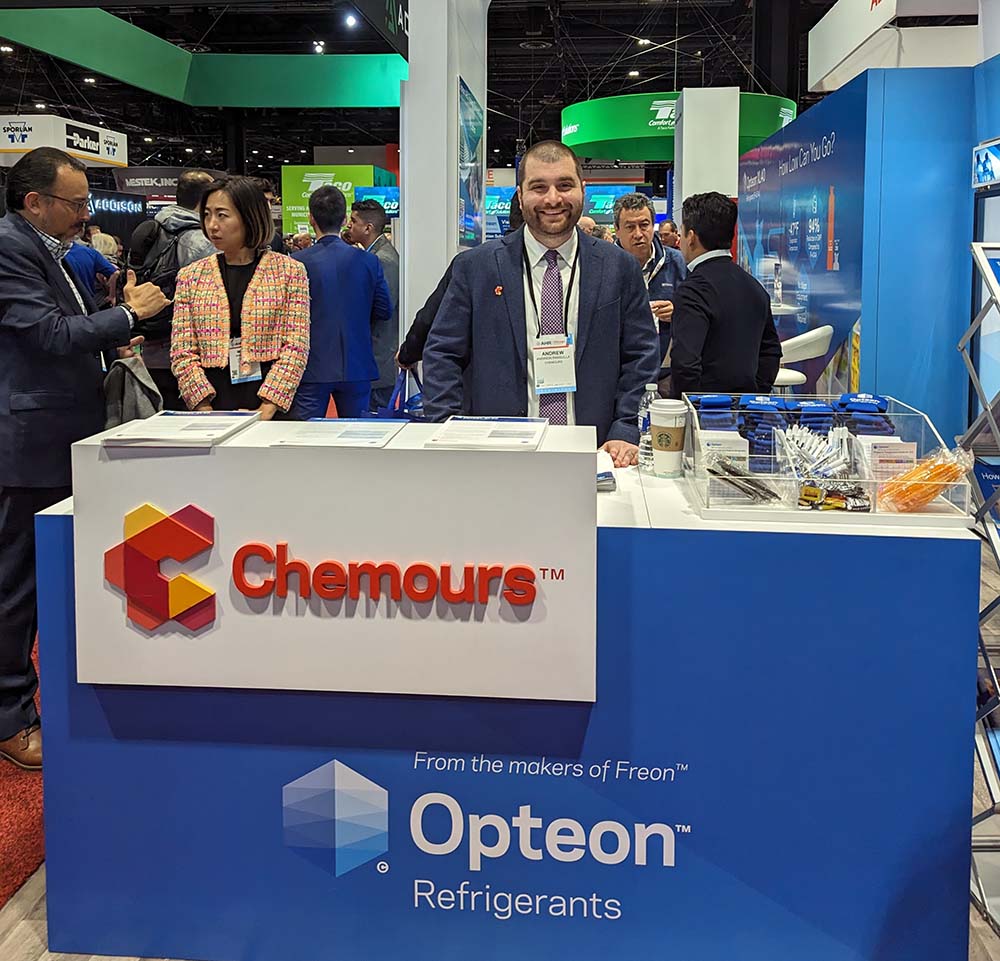
BEST BALANCE: Andrew Pansulla said that Chemours’ Opteon XL41 (R-454B) offers the best balance of properties, including first cost, energy cost, and GWP. (Courtesy of Chemours)
“These lower-GWP refrigerants assist with meeting the cuts prescribed by the phasedown, while maintaining or exceeding incumbent refrigerant performance,” he said. “The majority of North American air conditioning OEMs have specified Opteon XL41 (R-454B) because it offers the best balance of properties including first cost, energy cost, and GWP. For example, R-454B has a COP increase of 2.3% over R-410A.”
Moving to A2L refrigerants such as R-454B does come with some challenges, though, said Nick Strickland, Americas marketing manager of refrigerants at Chemours.
“One of the challenges we see is drawing a clear distinction between the flammability of A1, A2L, and A3 refrigerants. There seems to be confusion about this distinction, and we are working to share scientific tests that clearly show the differences between these characteristics,” he said. “Another challenge is that under the EPA’s Technology Transition final rule, certain segments like air conditioning seem to be on a good path regarding the lower-GWP limits; however, the perpetual servicing with higher GWP refrigerants has raised some questions.”
On the bright side, reducing refrigerant leak rates has always been a priority for the HVAC industry. Strickland said that the new safety standards for A2L systems will likely continue to mitigate the issue of leak rates.
“Because A2L refrigerants require leak detection, we believe traditional leak rates for A2Ls versus HFCs will be much lower,” he said. “We are excited that this technology will dramatically lower the Scope 1 emissions for our customers.”
Optimized Components
Copeland has prepared for the HVAC refrigerant transition by optimizing compressors, condensing units, electronic controls, and leak detection and associated components for use with lower-GWP A2L alternatives, said Stephen Hueckel, market manager at Copeland. He added that in recent years, the company has expanded its portfolio of A2L-optimized solutions to include commercial, light commercial, and residential air conditioners, chiller, and heat pump applications.
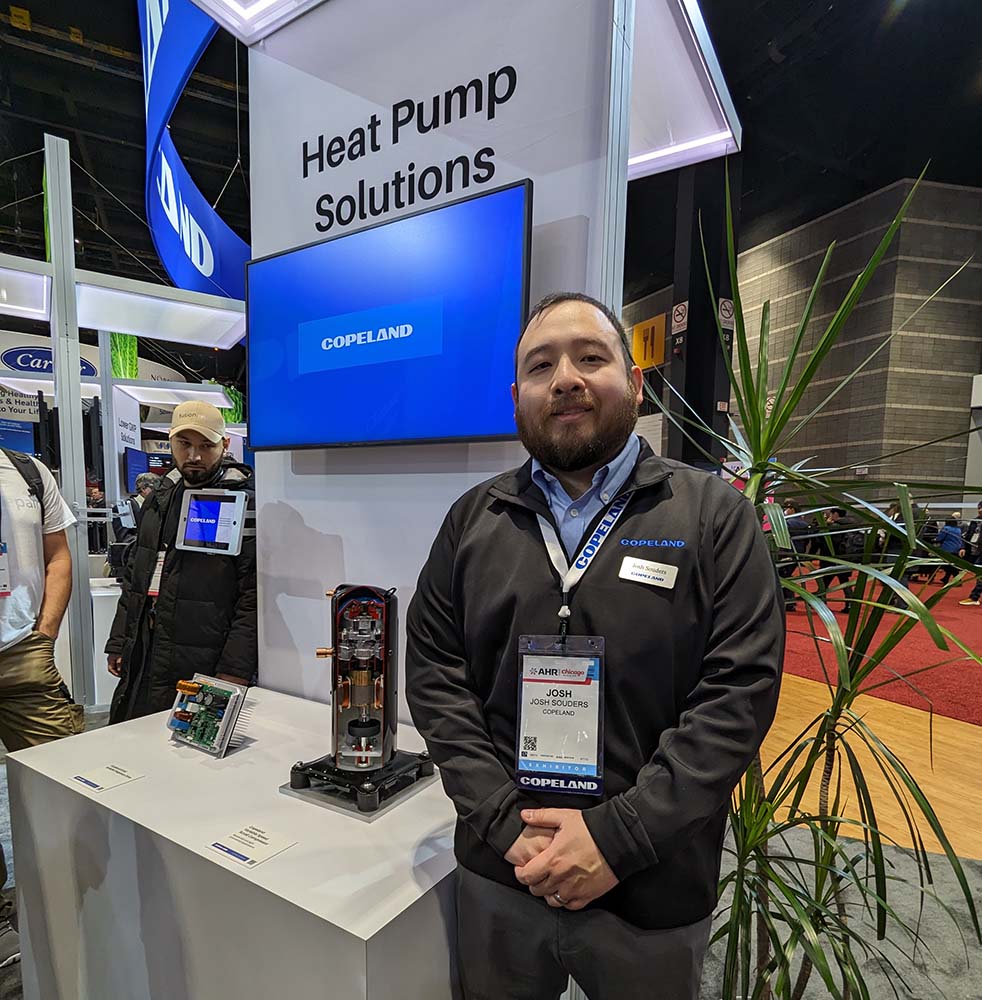
VARIABLE SPEED: Josh Souders showed off some of the variable-speed, lower-GWP heat pump solutions offered by Copeland. (Staff photo)
“To help meet the increasing demand for lower-GWP solutions, Copeland has made significant investments in its global laboratory and domestic manufacturing facilities to support A2L product development,” he said.
For residential OEMs that face potential redesigns in both their air conditioning and heat pump systems, Copeland has expanded its portfolio of next-generation compression technologies, optimized for HVAC applications to use the A2L refrigerants R-454B and R-32. Hueckel said that Copeland’s single- and two-stage compressors will be optimized for both refrigerant options, and their variable-speed compressors will be offered in R-454B.
On the commercial side, Copeland’s oil-free centrifugal compressor utilizes Aero-lift bearing technology to remove the complexities of oil management in air- or water-cooled chillers — without the costs, challenges, and limitations of magnetic levitation bearings, said Hueckel.
“Aero-lift bearing technology eliminates the need for complex electronics, sensors, and redundant backup bearings, enabling rapid restarting and smooth coasting to shut down during power disruptions. Our new oil-free centrifugal technology is also optimized for use with lower-GWP refrigerants such as R-513A, R-515B, and R-1234ze,” he said. “Copeland has also developed a full range of A2L-optimized solutions in our fixed-speed, two-stage, digital, and variable-speed platforms that deliver reliable performance and energy efficiency in a variety of commercial HVAC applications.”
With the 700 GWP limit on new stationary residential and light commercial air conditioners and heat pumps right around the corner, contractors who are not prepared to work with A2L refrigerants should make education and training their top priorities this year, said Hueckel.
“Although contractors’ concerns are understandable, most A2L servicing and handling tasks are based on existing refrigerant management best practices,” he said. “But it’s important for them to understand that A2L refrigerants cannot simply be added to existing R-410A systems. Further, working with mildly flammable refrigerants will require A2L-optimized leak detection and a dedicated set of tools and gauges. Contractors should seek out training from one of the many industry organizations and make efforts to educate themselves on servicing best practices.”
Minimizing Cost
EPA’s Technology Transition rule sets the stage for a significant shift in current HFC usage in the HVACR sector by imposing GWP limits on refrigerants used in new equipment, said Michael Mukai, global director of business development at Koura. As a result, he said that OEMs will need to quickly prepare for this shift by securing supplies of lower-GWP alternatives to be used in new systems and equipment.
“In large part, these new lower-GWP alternatives will come in the form of A2Ls, as they tend to be characterized by overall lower GWPs, low toxicity, and mild flammability,” he said. “An example of Koura’s offering in this area includes R-454B, a high-performing replacement for R-410A use in chillers and the HVAC sector.”
Mukai noted that Koura’s approach to meeting decreased HFC production is based on blend components used in other industries and applications.
“Our goal has been to minimize system development cost and validation timing,” he said. “These are two core principles of our refrigerant development. And because the development strategy is to minimize variation with incumbent refrigerant, each low-GWP refrigerant performs near its legacy counterpart, and often better.”
For example, R-456A (687 GWP) is an A1, direct replacement in R-134a systems that matches R-134a performance and efficiency with minimal system changes needed. Similarly, R-444A (93 GWP) is an A2L, zero-TFA (trifluoroacetic acid) direct replacement in R-1234yf systems and provides parity cooling performance at 10% higher efficiency. These options are ideal for appliances like heat pump water heaters and mobile air conditioning, said Mukai.
With the additional 30% cut in HFC production this year, adoption of lower-GWP refrigerants in HVAC equipment will come quickly, due to the supply-demand balance, said Adam Kimmel, senior manager of business development at Koura.
“Larger market segments could require more CO2e until they transition to lower-GWP solutions,” he said. “For comfort cooling, products like Koura 454B can meet intermediate-term GWP reduction targets to extend CO2e allowances to allow higher refrigerant amounts. But with another 30% cut in HFC production set to hit in January 2029, Koura is already well into development of next-generation, zero-TFA, low-GWP refrigerants like R-R-444A, and the zero-PFAS R-485A, an enhanced CO2 blend offering better high-ambient performance and efficiency than legacy R-744 (CO2 refrigerant).”



Report Abusive Comment